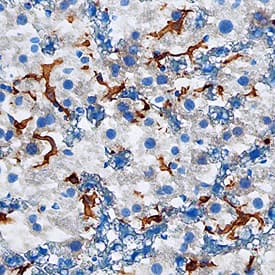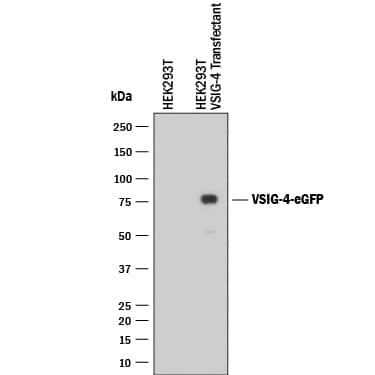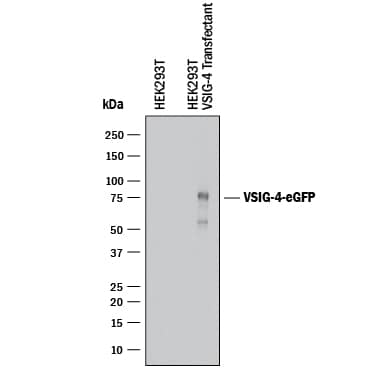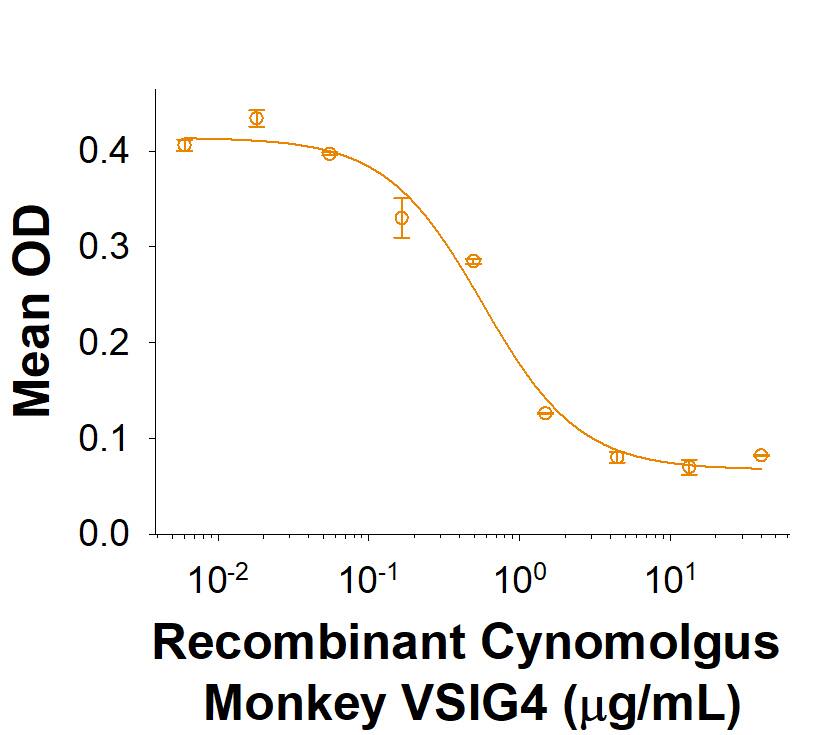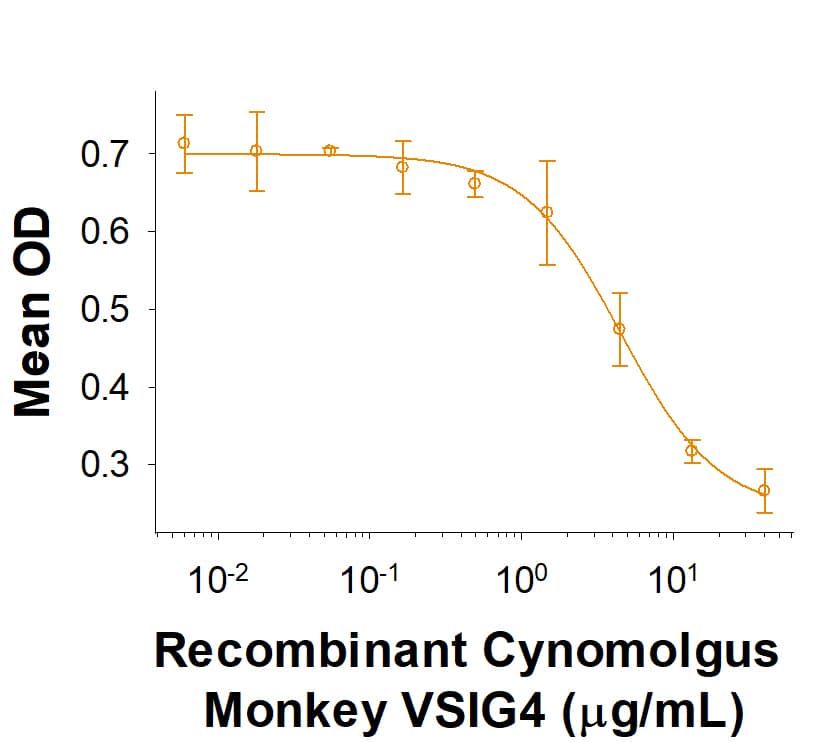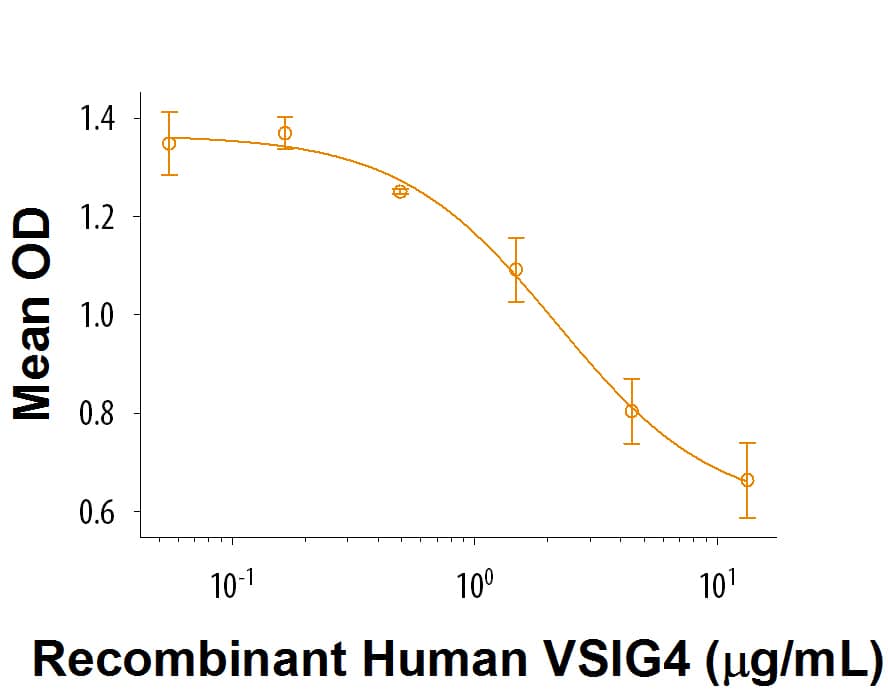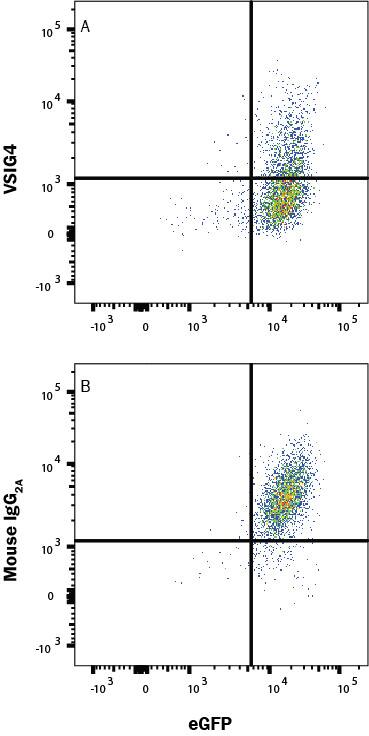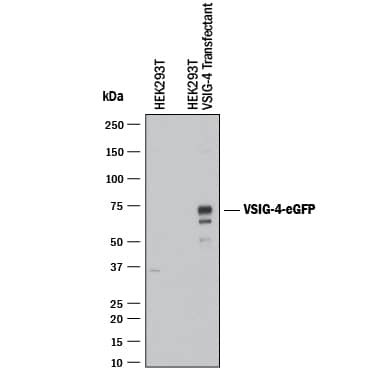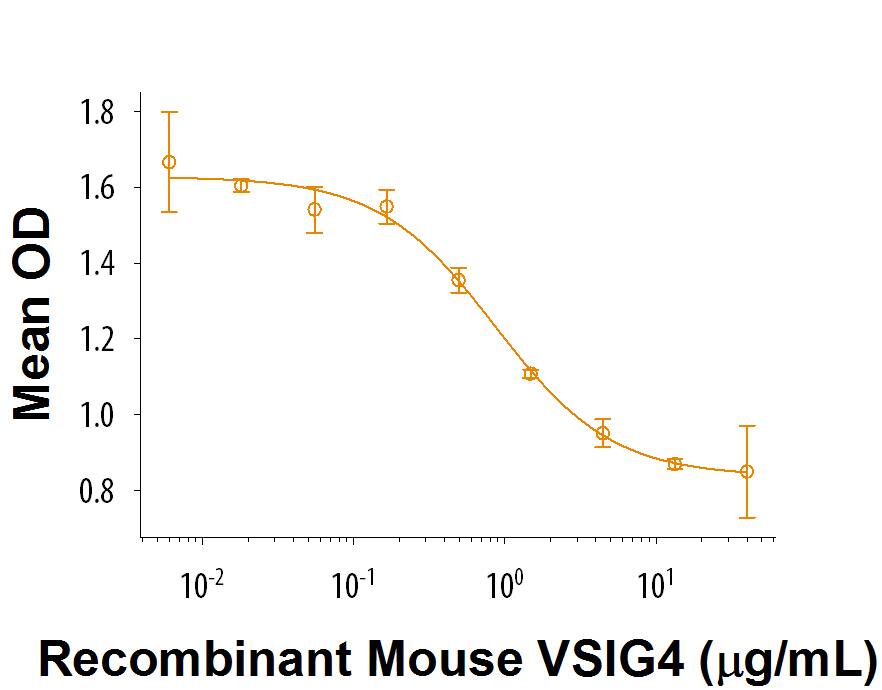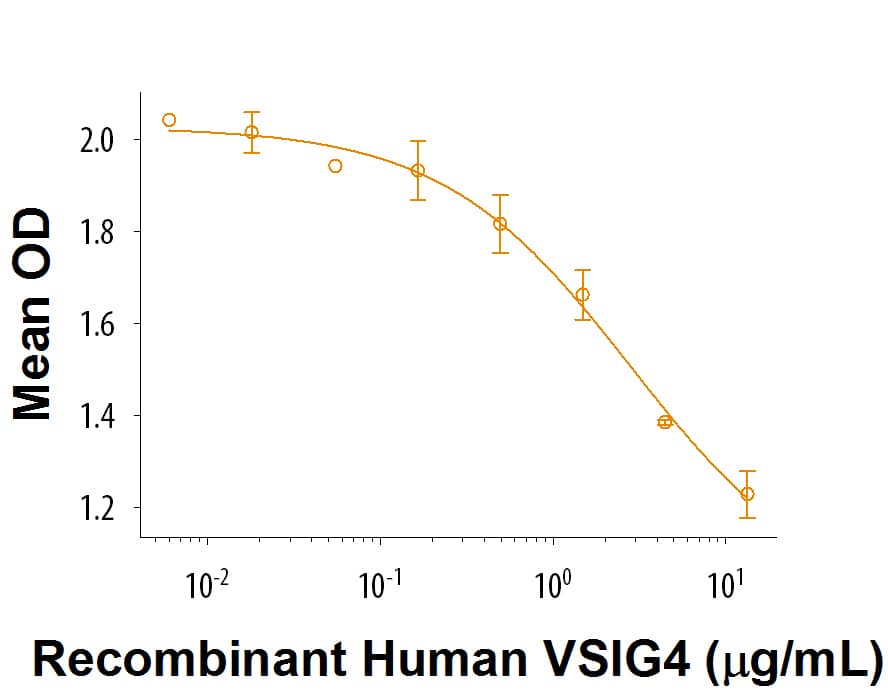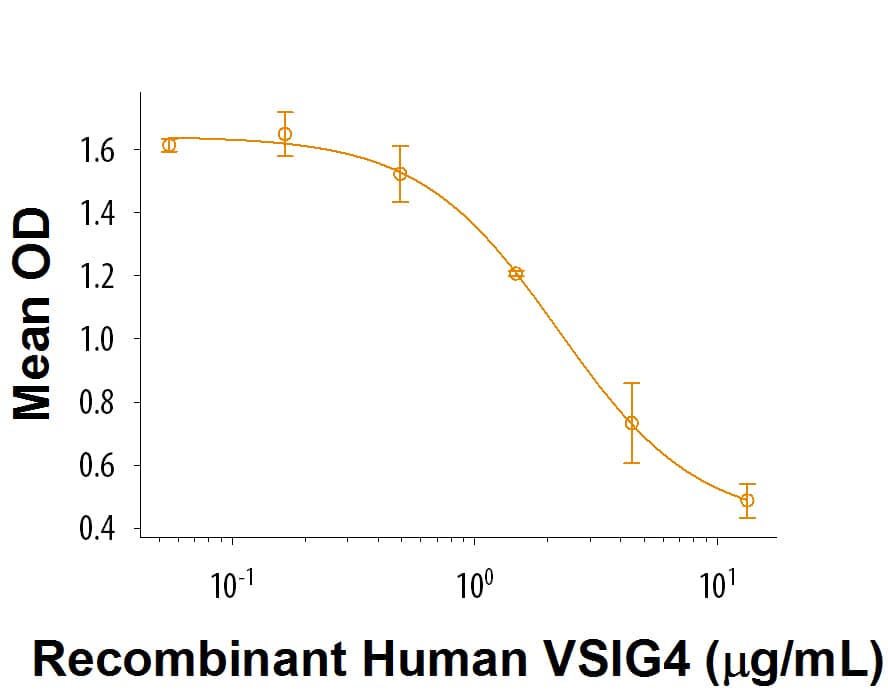VSIG4 Products
VSIG4 (V-set and immunoglobulin domain containing 4), also known as CRIg and Z39IG, is a 45 kDa, type I transmembrane protein of the B7 family within the Ig superfamily that is expressed only in tissue-resident macrophages. The gene is located on the X chromosome. The human VSIG4 cDNA encodes 399 amino acids (aa) including a 19 aa signal sequence, a 264 aa extracellular domain (ECD) containing a V-type and a C2-type Ig domain, a 21 aa transmembrane domain and a 95 aa cytoplasmic domain. The human VSIG4 ECD shares 84% aa identity with canine VSIG4. Within the IgV domain, it shares 90%, 80% and 78% aa identity with bovine, mouse and rat VSIG4, respectively; these animals lack the C2-type domain. Splice isoforms of 321, 305, 272, 201 and 199 aa lack all or part of the cytoplasmic domain, the C2-type Ig domain and/or the transmembrane domain. VSIG4 is specifically expressed on macrophages in the thymic medulla, peritoneum, alveoli, synovia, adipose and heart, liver Kupffer cells, placental Hofbauer cells, and atherosclerotic foam cells. It is absent on infiltrating macrophages. VSIG4 is a complement receptor that binds C3b and iC3b fragments, internalizes them to recycling endosomes, and is recycled to the cell surface. It contributes significantly to innate immunity by binding and phagocytosis of complement-opsonized invading pathogens. Binding of either native or recombinant soluble VSIG4 to C3b inhibits complement amplification through the alternative, but not classical, pathway. VSIG4 is also a negative regulator of mouse and human T cell activation. Although VSIG4 engagement may activate NF-kappa-B and thus be pro-inflammatory in some cases, many of its activities are important in resolving, rather than initiating, inflammation.
99 results for "VSIG4" in Products
99 results for "VSIG4" in Products
VSIG4 Products
VSIG4 (V-set and immunoglobulin domain containing 4), also known as CRIg and Z39IG, is a 45 kDa, type I transmembrane protein of the B7 family within the Ig superfamily that is expressed only in tissue-resident macrophages. The gene is located on the X chromosome. The human VSIG4 cDNA encodes 399 amino acids (aa) including a 19 aa signal sequence, a 264 aa extracellular domain (ECD) containing a V-type and a C2-type Ig domain, a 21 aa transmembrane domain and a 95 aa cytoplasmic domain. The human VSIG4 ECD shares 84% aa identity with canine VSIG4. Within the IgV domain, it shares 90%, 80% and 78% aa identity with bovine, mouse and rat VSIG4, respectively; these animals lack the C2-type domain. Splice isoforms of 321, 305, 272, 201 and 199 aa lack all or part of the cytoplasmic domain, the C2-type Ig domain and/or the transmembrane domain. VSIG4 is specifically expressed on macrophages in the thymic medulla, peritoneum, alveoli, synovia, adipose and heart, liver Kupffer cells, placental Hofbauer cells, and atherosclerotic foam cells. It is absent on infiltrating macrophages. VSIG4 is a complement receptor that binds C3b and iC3b fragments, internalizes them to recycling endosomes, and is recycled to the cell surface. It contributes significantly to innate immunity by binding and phagocytosis of complement-opsonized invading pathogens. Binding of either native or recombinant soluble VSIG4 to C3b inhibits complement amplification through the alternative, but not classical, pathway. VSIG4 is also a negative regulator of mouse and human T cell activation. Although VSIG4 engagement may activate NF-kappa-B and thus be pro-inflammatory in some cases, many of its activities are important in resolving, rather than initiating, inflammation.
| Reactivity: | Mouse |
| Details: | Goat IgG Polyclonal |
| Applications: | IHC |
| Reactivity: | Human |
| Details: | Goat IgG Polyclonal |
| Applications: | WB |
| Source: | NS0 |
| Accession #: | Q9Y279 |
| Applications: | BA |
| Reactivity: | Human |
| Details: | Mouse IgG2a Monoclonal Clone #528903 |
| Applications: | WB, Flow, CyTOF-ready |
Recombinant Monoclonal Antibody.
| Reactivity: | Human |
| Details: | Rabbit IgG Monoclonal Clone #2174B |
| Applications: | Flow |
Biotinylated
| Source: | HEK293 |
| Accession #: | Q9Y279.1 |
| Applications: | BA, BA |
Recombinant Monoclonal Antibody.
| Reactivity: | Human |
| Details: | Rabbit IgG Monoclonal Clone #2174B |
| Applications: | WB, Flow |
Recombinant Monoclonal Antibody.
| Reactivity: | Human |
| Details: | Rabbit IgG Monoclonal Clone #2174B |
| Applications: | Flow |
Recombinant Monoclonal Antibody.
| Reactivity: | Human |
| Details: | Rabbit IgG Monoclonal Clone #2174B |
| Applications: | Flow |
| Source: | NS0 |
| Accession #: | NP_808457 |
| Applications: | BA |
| Reactivity: | Human |
| Details: | Goat IgG Polyclonal |
| Applications: | WB |
| Source: | HEK293 |
| Accession #: | XP_005593850.1 |
| Applications: | BA |
| Source: | HEK293 |
| Accession #: | XP_005593850.1 |
| Applications: | BA |
| Source: | CHO |
| Accession #: | Q9Y279-3 |
| Applications: | BA |
| Reactivity: | Human |
| Details: | Mouse IgG2a Monoclonal Clone #528912 |
| Applications: | Block |
| Reactivity: | Human |
| Details: | Mouse IgG2b Monoclonal Clone #528927 |
| Applications: | WB, ICC |
| Source: | NS0 |
| Accession #: | NP_808457 |
| Applications: | BA |
| Source: | NS0 |
| Accession #: | Q9Y279-1 |
| Applications: | BA |
| Source: | NS0 |
| Accession #: | Q9Y279 |
| Applications: | BA |
Recombinant Monoclonal Antibody.
| Reactivity: | Human |
| Details: | Rabbit IgG Monoclonal Clone #2174B |
| Applications: | Flow |
| Reactivity: | Human |
| Details: | Mouse IgG2a Monoclonal Clone #528903 |
| Applications: | Flow |
| Reactivity: | Human |
| Details: | Mouse IgG2a Monoclonal Clone #528903 |
| Applications: | Flow |
| Reactivity: | Human |
| Details: | Mouse IgG2a Monoclonal Clone #528903 |
| Applications: | Flow |
| Source: | CHO |
| Accession #: | Q9Y279-3 |
| Applications: | BA |

